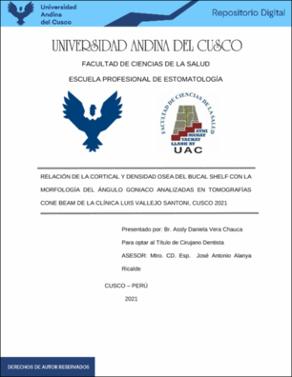| dc.contributor.advisor | Alanya Ricalde, José Antonio | |
| dc.contributor.author | Vera Chauca, Assly Daniela | |
| dc.date.accessioned | 2021-10-15T01:25:33Z | |
| dc.date.available | 2021-10-15T01:25:33Z | |
| dc.date.issued | 2021-06-30 | |
| dc.identifier.uri | https://hdl.handle.net/20.500.12557/4170 | |
| dc.description.abstract | Introducción: Hoy en día los minitornillos están empezando a ser un gran aliado en
tratamientos ortodónticos, siendo usados como un sistema de anclaje para acortar tiempos
de tratamientos, para esto se necesita un lugar óptimo para la colocación de estos en el
cual se hace una evaluación de densidad y cortical para la inserción de esto, este puede
ser alterado por la morfología del ángulo goniaco. Objetivo: Esta investigación fue para
determinar una relación de la cortical y densidad ósea en el área bucal shelf con relación a
la morfología del ángulo goniaco que serán analizadas en tomografías cone beam. Método:
Esta investigación tuvo un alcance con enfoque cuantitativo, no experimental, transversal y
correlacional; se realizó en 283 imágenes tomográficas cone beam (10-84 años de edad)
en los cuales se analizó la morfología del ángulo goniaco, teniendo así tres grupos de
hipodivergente, normodivergente y hiperdivergente; se hizo en estos las mediciones de
densidad y cortical en el área del bucal shelf.
Resultados: No se encontró una relación estadísticamente significativa entre densidad y
cortical con la morfología del ángulo goniaco en el área estudiada, en cuanto a la densidad
ósea en relación a las edades 41 a 50 años de edad se encontró un mayor porcentaje de
densidad (854.16UH) siendo el rango más alto, se pudo observar que el patrón facial
hipodivergente fue el que tuvo un rango más alto en relación al cortical , teniendo así que
el patrón hipodivergente tiene un cortical grueso (>2.5mm). Conclusión: No se estableció
una relación significativa entre cortical y densidad con la morfología del ángulo goniaco,
pero se halló rangos de edad óptimos en cuanto a densidad y una distancia óptima para el
cortical. | es_PE |
| dc.description.abstract | Introduction: The miniature screws nowadays are beginning to be a great ally in orthodontic
treatments, being used as an anchoring system to shorten treatment times, for this an
optimal place is needed for the placement of these in which it is done a density and cortical
evaluation for the insertion of this, this can be altered by the morphology of the goniac angle.
Objective: this research was to determine a relationship between the cortical and bone
density in the buccal shelf area in relation to the morphology of the goniac angle that will be
analyzed in cone beam tomography. Method: This research had a scope with a quantitative,
non-experimental, cross-sectional and correlational approach; It was performed on 283 cone
beam tomographic images (10-84 years of age) in which the morphology of the goniac angle
was analyzed, thus having three groups: hypodivergent, normodivergent and
hyperdivergent; Density and cortical measurements were made on these in the buccal shelf
area.
Results: A statistically significant relationship was not found between density and cortical
bone with the morphology of the goniac angle in the studied area, in terms of bone density
in relation to ages 41 to 50 years of age, a higher percentage of density was found (854.16
UH) being the highest range, it was observed that the hypodivergent facial pattern was the
one that had a higher range in relation to the cortical, thus having the hypodivergent pattern
having a cortical thickness (> 2.5mm). Conclusion: A significant relationship between
cortex and density was not established with the morphology of the goniac angle, but optimal
age ranges were found in terms of density and an optimal distance for the cortex. | en_US |
| dc.format | application/pdf | es_PE |
| dc.language.iso | spa | es_PE |
| dc.publisher | Universidad Andina del Cusco | es_PE |
| dc.rights | info:eu-repo/semantics/openAccess | es_PE |
| dc.rights.uri | https://creativecommons.org/licenses/by-nc-nd/4.0/ | es_PE |
| dc.subject | Relación | es_PE |
| dc.subject | Cortical | es_PE |
| dc.subject | Densidad | es_PE |
| dc.subject | Morfología del ángulo goniaco | es_PE |
| dc.subject | Hipodivergente | es_PE |
| dc.title | Relación de la cortical y densidad ósea del bucal shelf con la morfología del ángulo goniaco analizadas en tomografías Cone Beam de la Clínica Luis Vallejo Santoni, Cusco 2021 | es_PE |
| dc.type | info:eu-repo/semantics/bachelorThesis | es_PE |
| thesis.degree.name | Cirujana Dentista | es_PE |
| thesis.degree.grantor | Universidad Andina del Cusco. Facultad de Ciencias de la Salud | es_PE |
| thesis.degree.discipline | Estomatología | es_PE |
| dc.publisher.country | PE | es_PE |
| dc.subject.ocde | https://purl.org/pe-repo/ocde/ford#3.02.14 | es_PE |
| renati.advisor.dni | 24002230 | |
| renati.advisor.orcid | https://orcid.org/0000-0003-4752-9983 | es_PE |
| renati.author.dni | 73020100 | |
| renati.discipline | 911016 | es_PE |
| renati.juror | Arenas Fernández Dávila, Jesús Alejandro | |
| renati.juror | Lazo Álvarez, Julio | |
| renati.juror | Herrera Menéndez, Cesar Enrique | |
| renati.juror | Gamero Huarcaya, Valery Kimiyo | |
| renati.level | https://purl.org/pe-repo/renati/level#tituloProfesional | es_PE |
| renati.type | https://purl.org/pe-repo/renati/type#tesis | es_PE |


